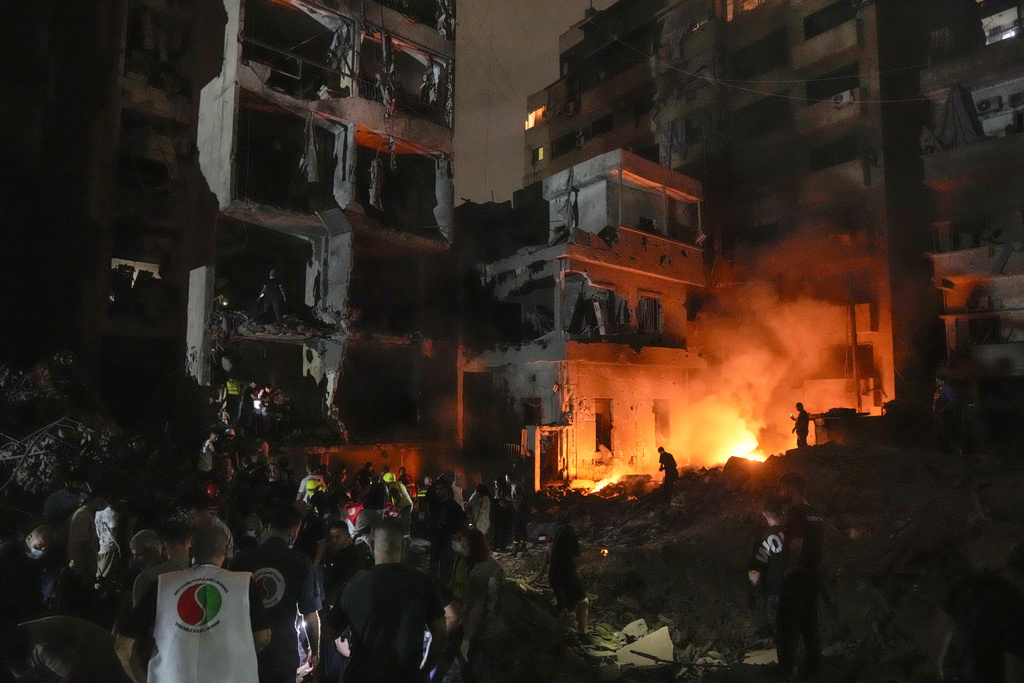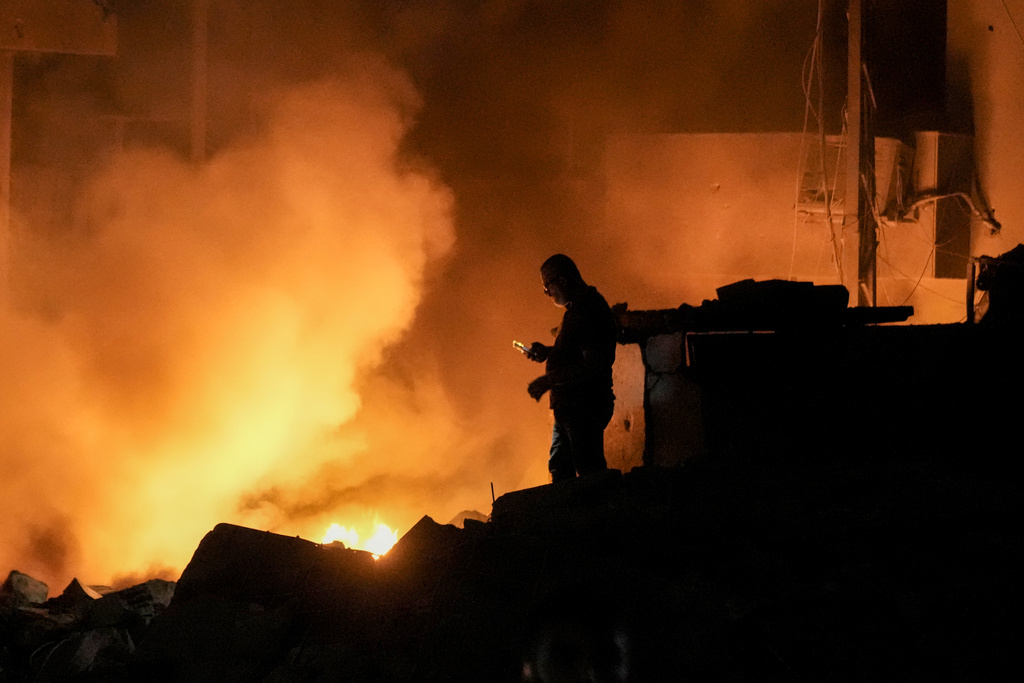Israel Hits Central Beirut: 22 Killed, Dozens Injured in Escalation \ Newslooks \ Washington DC \ Mary Sidiqi \ Evening Edition \ Israeli airstrikes hit central Beirut, killing 22 people and injuring dozens, marking a deadly escalation in the conflict between Israel and Hezbollah. The strikes, which targeted residential buildings, come after months of heightened tensions and exchanges between the two sides. Lebanon’s health ministry reported the casualties, while Hezbollah stated an assassination attempt on a key official had failed.

Israeli Strikes on Beirut Quick Looks:
- Israeli airstrikes targeted central Beirut, killing 22 and injuring over 100.
- Strikes hit two residential buildings in separate neighborhoods, leveling one building entirely.
- Hezbollah confirmed a failed attempt to kill top security official Wafiq Safa.
- Hezbollah has increased rocket attacks on Israel, pushing the conflict into more populated areas.
- Israeli military is investigating the strikes, which were the deadliest in over a year.
Deep Look:
Israeli airstrikes on Thursday tore through two neighborhoods in central Beirut, killing 22 people and leaving dozens wounded, according to Lebanon’s health ministry. The strikes marked a severe escalation in the ongoing conflict between Israel and Hezbollah, the Iran-backed militant group based in Lebanon. The air raid, which targeted two residential buildings in separate areas of Beirut, is the deadliest attack in over a year of mounting tensions between Israel and Hezbollah.
The Israeli military has said it is investigating the strikes, which hit the Ras al-Nabaa neighborhood and Burj Abi Haidar area, both densely populated sections of the city. The Lebanese Health Ministry confirmed that 22 people were killed and 117 were wounded, but it did not specify whether the casualties included civilians, Hezbollah militants, or both. An Associated Press photographer at the scene described one eight-story building reduced to rubble, while another building had its lower floors obliterated.
While Israeli strikes on Hezbollah strongholds in southern Beirut have been relatively common, Thursday’s attack on central Beirut represents a significant shift in the geographic scope of the conflict. The densely packed southern suburbs are traditionally where Hezbollah operates and maintains its bases, making these residential strikes in central Beirut a chilling escalation in the ongoing violence.
Shortly after the strikes, Hezbollah’s Al Manar TV reported that one of the targets was an attempt to assassinate Wafiq Safa, a top security official within the group. The report confirmed that Safa was not inside either of the targeted buildings, and the assassination attempt had failed. The Israeli military has neither confirmed nor denied the target of the strike.
Thursday’s attack follows more than a year of sporadic exchanges between Hezbollah and Israel that have escalated into full-blown war in recent weeks. The conflict saw Israel launch waves of heavy airstrikes across Lebanon and carry out a ground invasion. Meanwhile, Hezbollah has expanded its rocket attacks, pushing deeper into populated areas of Israel. Though casualties in Israel have been limited, the rocket fire has disrupted daily life in many northern Israeli towns.
Tensions between Israel and Hezbollah have risen steadily since October 2023, when Hezbollah began launching rockets in support of Hamas and the Palestinians. This prompted retaliatory Israeli airstrikes. Hezbollah’s missile attacks have caused relatively few casualties, but the psychological and economic toll of these attacks has been significant for both sides.
Adding to the escalation, Thursday’s airstrikes coincided with another dangerous development: Israeli forces opened fire on United Nations peacekeepers stationed in southern Lebanon, wounding two Indonesian peacekeepers. This incident drew sharp condemnation from the international community and prompted Italy’s Defense Ministry to summon Israel’s ambassador in protest. The Israeli military acknowledged firing at a U.N. base, claiming that it had instructed peacekeepers to “remain in protected spaces.”
The U.N. peacekeeping force, known as UNIFIL, has had a significant presence in southern Lebanon for decades, monitoring the tense border region. However, as the conflict has intensified, UNIFIL’s positions have repeatedly come under fire. On Thursday, U.N. peacekeeping chief Jean-Pierre Lacroix revealed that 300 peacekeepers had been moved to larger bases due to security concerns. The peacekeepers are remaining in place but have had to suspend patrols due to ongoing air and ground attacks.
The strikes on Beirut come amid a larger regional escalation, as Iran, which supports both Hezbollah and Hamas, launched 180 ballistic missiles at Israel last week in retaliation for the killing of senior Hamas and Hezbollah militants. Israeli Defense Minister Yoav Gallant has warned that Israel’s response to these missile attacks will be “lethal” and “surprising,” though details of the planned retaliation remain unclear.
U.S. Vice President Kamala Harris, speaking from Las Vegas, called for an urgent ceasefire. “We have got to reach a cease-fire, both in Lebanon and Gaza. We need these wars to end and de-escalate what is happening in the region,” Harris said.
The conflict has had devastating consequences for Lebanon. Since October 2023, Israeli airstrikes have killed over 2,169 people across Lebanon, according to Lebanon’s crisis response unit. In the same period, Hezbollah’s rocket attacks have claimed the lives of 28 Israeli civilians and 39 Israeli soldiers.
The violence has displaced thousands of Lebanese civilians, particularly in the southern regions near the Israeli border, where Israel’s ground invasion remains focused. The Israeli military says the objective of its ground invasion is to push Hezbollah militants back from the border area, enabling tens of thousands of Israelis who fled the region to return to their homes.
Israel’s military action in Lebanon is part of a broader, multi-front conflict. While attention has shifted toward Israel’s confrontation with Hezbollah in Lebanon and its tensions with Iran, the situation in Gaza remains dire. On Thursday, an Israeli airstrike hit a school in central Gaza that was sheltering displaced civilians. At least 27 people were killed in the strike, including seven women and a child, according to the Al-Aqsa Martyrs Hospital.
The Israeli military claimed it was targeting Palestinian militants who had taken refuge in the school. However, survivors said that the strike hit a gathering of aid workers instead. “There were no militants. There was no Hamas,” said Iftikhar Hamouda, a survivor who had fled northern Gaza earlier in the war. “In the schools, they bombed us,” she added, echoing the desperation felt by many civilians trapped in the crossfire.
Israel’s offensive in Gaza, launched in response to the October 7 Hamas attack that killed 1,200 Israelis, has led to devastating losses. Palestinian authorities in Gaza report that over 42,000 Palestinians have been killed, and large areas of Gaza have been destroyed. Around 90% of Gaza’s population of 2.3 million has been displaced, many forced to move multiple times as the conflict rages on.
Israel Hits Israel Hits Israel Hits







